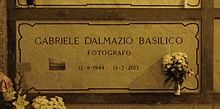Gabriele Basilico: Difference between revisions
Madamadore00 (talk | contribs) |
Madamadore00 (talk | contribs) |
||
| Line 23: | Line 23: | ||
*''Bord de mer'' (Contrasto, 2012) {{ISBN|9788869657153}} |
*''Bord de mer'' (Contrasto, 2012) {{ISBN|9788869657153}} |
||
*''Gabriele Basilico. Iran 1970'' (Humboldt Books, 2015) {{ISBN|9788890841873}} |
*''Gabriele Basilico. Iran 1970'' (Humboldt Books, 2015) {{ISBN|9788890841873}} |
||
*''Matosinhos. Non c’è architettura senza luce'' (Corsiero editore, 2017) {{ISBN|978-88-98420-62-9}} |
|||
*''Gabriele Basilico. Metropoli.'' (Skira, 2020) {{ISBN|9788857243153}} |
*''Gabriele Basilico. Metropoli.'' (Skira, 2020) {{ISBN|9788857243153}} |
||
*''non recensiti'' (Humboldt Books, 2021) {{ISBN|9788899385866}} |
*''non recensiti'' (Humboldt Books, 2021) {{ISBN|9788899385866}} |
||
Revision as of 10:44, 31 May 2023
Gabriele Basilico (12 August 1944 – 13 February 2013) was an Italian photographer[1][2][3] who defined himself as "a measurer of space".[4]
Born in Milan, Italy in 1944, he originally studied to become an architect before pursuing a career in photography. His initial works focused around traditional landscape photography, but he later shifted his focus to architectural photography due to the influence of his previous studies in architecture. He achieved international fame in 1982 with his photographic report on the industrial areas of Milan, "Ritratti di Fabbriche, Sugarco".[5]

In the mid-1980s he was part of a group of photographers commissioned by the French Government to document the transformation of the Transalpine landscape.[5]
In 1991 his photographs helped to document the effects of war on the Lebanese capital of Beirut with his celebrated work, "Beirut 1991".[4][5]
His last public work was showcased in December 2012, at the inauguration of a new square, Gae Aulenti, in Milan. The work consisted of a series of photographs that portrayed the Porta Nuova Project from its inception through completion.[6]
The majority of Basilico's work was done using a traditional viewfinder camera and black and white film. He was awarded the Osella d'Oro at the 1996 Venice Biennale.[7]
Publications
- Milano ritratti di fabbriche (Sugarco edizioni, 1981) ISBN 9788871796277
- Porti di mare (Art&, 1990) ISBN 9788885893207
- Scattered City (Le Point du Jour, 2007) ISBN 8842420484
- Architetture, città, visioni (Bruno Mondadori, 2007) ISBN 8842420484
- Mosca verticale. (Federico Motta, 2008) ISBN 887179589X
- Beirut 1991 (2003) – Gabriele Basilico (Baldini Castoldi Dalai, 2008) ISBN 978-8884903815
- Leggere le fotografie in dodici lezioni (Rizzoli, 2012) ISBN 9788817056908
- Bord de mer (Contrasto, 2012) ISBN 9788869657153
- Gabriele Basilico. Iran 1970 (Humboldt Books, 2015) ISBN 9788890841873
- Matosinhos. Non c’è architettura senza luce (Corsiero editore, 2017) ISBN 978-88-98420-62-9
- Gabriele Basilico. Metropoli. (Skira, 2020) ISBN 9788857243153
- non recensiti (Humboldt Books, 2021) ISBN 9788899385866
References
- ^ "Archivio Gabriele Basilico". Archivio Gabriele Basilico.
- ^ "Gabriele Basilico". Galleria Valeria Bella.
- ^ "Gabriele Basilico". Blog Alessandro Mallamaci (in Italian).
- ^ a b Mario Calabresi (14 February 2013). "Gabriele Basilico, la poesia del misuratore di spazi". La Stampa. Retrieved 16 February 2013.
- ^ a b c Redazione Milano (13 February 2013). "È morto il fotografo Gabriele Basilico". Il Corriere della Sera. Retrieved 16 February 2013.
- ^ Piero Negri (13 February 2013). "È morto Gabriele Basilico il fotografo delle città". La Stampa. Retrieved 16 February 2013.
- ^ Hopkinson, Amanda (25 February 2013). "Gabriele Basilico obituary". The Guardian.
